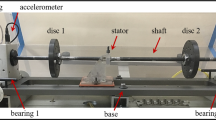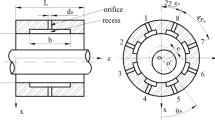Abstract
This work presents a model reduction method suited for performing nonlinear dynamic analysis of high-dimensional rotor-foundation systems modeled by the finite element method. The approach consists in combining the component mode synthesis (CMS) method with the approximate invariant manifold method (AIMM), and allows the obtention of forced responses through the integration of a single pair of ordinary differential equations. The proposed approach is tested using two examples: a simple and a complex rotor-foundation system. In both cases, the nonlinearity comes from the fluid-film bearings. The results show that the method can provide a significant reduction in numerical cost while still retaining good accuracy when compared to direct time integrations. By means of the proposed method, the nonlinear dynamic analysis of high-dimensional rotor-foundation system becomes a feasible option.





















Similar content being viewed by others
Data availability
The datasets generated during and analyzed during the current study are not publicly available but are available from the corresponding author on reasonable request.
References
Nicholas, J.C., Barrett, L.E.: The effect of bearing support flexibility on critical speed prediction. ASLE Transactions 29(3), 329–338 (1986). https://doi.org/10.1080/05698198608981693
Kang, Y., Chang, Y.P., Tsai, J.W., Mu, L.H., Chang, Y.F.: An investigation in stiffness effects on dynamics of rotor-bearing-foundation systems. J. Sound Vib. 231(2), 343–374 (2000). https://doi.org/10.1006/jsvi.1999.2719
Vance, J.M., Murphy, B., Zeidan, F.: Machinery Vibration and Rotordynamics. Wiley, Hoboken (2010)
Muszynska, A.: Stability of whirl and whip in rotor/bearing systems. J. Sound Vib. 127(1), 49–64 (1988). https://doi.org/10.1016/0022-460X(88)90349-5
de Castro, H.F., Cavalca, K.L., Nordmann, R.: Whirl and whip instabilities in rotor-bearing system considering a nonlinear force model. J. Sound Vib. 317(1–2), 273–293 (2008). https://doi.org/10.1016/j.jsv.2008.02.047
Lund, J.W.: The stability of an elastic rotor in journal bearings with flexible, damped supports. J. Appl. Mech. 32(4), 911–920 (1965). https://doi.org/10.1115/1.3627335
Chasalevris, A.: Stability and Hopf bifurcations in rotor-bearing-foundation systems of turbines and generators. Tribol. Int. 145, 106–154 (2020). https://doi.org/10.1016/j.triboint.2019.106154
Gavalas, I., Chasalevris, A.: Nonlinear dynamics of turbine generator shaft trains: evaluation of bifurcation sets applying numerical continuation. J. Eng. Gas Turbines Power (2022). https://doi.org/10.1115/1.4055533
Štimac, G., Braut, S., Žigulić, R.: Optimization of the machine foundation using frequency constraints. Struct. Multidiscip. Optim. 50(1), 147–157 (2014). https://doi.org/10.1007/s00158-014-1052-8
Bhattacharya, S.: In: Rao, A.R.M., Ramanjaneyulu, K. (eds.) Recent Advances in Structural Engineering. Lecture Notes in Civil Engineering, vol. 1, pp. 3–17. Springer, Singapore (2019). https://doi.org/10.1007/978-981-13-0362-3_1
Gasch, R.: Vibration of large turbo-rotors in fluid-film bearings on an elastic foundation. J. Sound Vib. 47(1), 53–73 (1976). https://doi.org/10.1016/0022-460X(76)90407-7
Bonello, P., Brennan, M.J.: Modelling the dynamic behaviour of a supercritical rotor on a flexible foundation using the mechanical impedance technique. J. Sound Vib. 239(3), 445–466 (2001). https://doi.org/10.1006/jsvi.2000.3172
Cavalca, K.L., Okabe, E.P.: In: Gupta, K. (ed.) IUTAM Symposium on Emerging Trends in Rotor Dynamics, pp. 89–101. Springer, Netherlands, Dordrecht (2011). https://doi.org/10.1007/978-94-007-0020-8_8
Cavalca, K.L., Cavalcante, P.F., Okabe, E.P.: An investigation on the influence of the supporting structure on the dynamics of the rotor system. Mech. Syst. Signal Process. 19(1), 157–174 (2005). https://doi.org/10.1016/j.ymssp.2004.04.001
Edwards, S., Lees, A.W., Friswell, M.I.: Experimental identification of excitation and support parameters of a flexible rotor-bearings-foundation system from a single run-down. J. Sound Vib. 232(5), 963–992 (2000). https://doi.org/10.1006/jsvi.1999.2779
Saint Martin, L.B., Gusmão, L.L., Machado, T.H., Okabe, E.P., Cavalca, K.L.: Operational modal analysis application to support structure identification under rotating machinery unbalance. Eng. Struct. 249, 113344 (2021). https://doi.org/10.1016/j.engstruct.2021.113344
Power, R.B., Wood, D.E.: 2000-hp Motor support structure vibration sensitivity: tests, finite element analysis, and suggested strategies for prevention. J. Vib. Acoust. Stress. Reliab. Des. 106(1), 113–121 (1984). https://doi.org/10.1115/1.3269139
Kuemmlee, H., Siegl, G., Woywode, P.: In: 2008 5th Petroleum and Chemical Industry Conference Europe - Electrical and Instrumentation Applications, pp. 1–8. IEEE, Weimar (2008). https://doi.org/10.1109/PCICEUROPE.2008.4563530
Hajžman, M., Balda, M., Polcar, P., Polach, P.: Turbine rotor dynamics models considering foundation and stator effects. Machines 10(2), 77 (2022). https://doi.org/10.3390/machines10020077
Craig, R.R., Jr.: Substructure methods in vibration. J. Vib. Acoust. 117(B), 207–213 (1995). https://doi.org/10.1115/1.2838665
Allen, M.S., Rixen, D., van der Seijs, M., Tiso, P., Abrahamsson, T., Mayes, R.L.: Substructuring in Engineering Dynamics: Emerging Numerical and Experimental Techniques. In: CISM International Centre for Mechanical Sciences, vol. 594. Springer, Cham (2020). https://doi.org/10.1007/978-3-030-25532-9
Craig, R.R., Bampton, M.C.C.: Coupling of substructures for dynamic analyses. AIAA J. 6(7), 1313–1319 (1968). https://doi.org/10.2514/3.4741
Macneal, R.H.: A hybrid method of component mode synthesis. Comput. Struct. 1(4), 581–601 (1971). https://doi.org/10.1016/0045-7949(71)90031-9
Rubin, S.: Improved component-mode representation for structural dynamic analysis. AIAA J. 13(8), 995–1006 (1975). https://doi.org/10.2514/3.60497
Seshu, P.: Substructuring and component mode synthesis. Shock. Vib. 4(3), 199–210 (1997). https://doi.org/10.3233/SAV-1997-4306
de Klerk, D., Rixen, D.J., Voormeeren, S.N.: General framework for dynamic substructuring: history, review and classification of techniques. AIAA J. 46(5), 1169–1181 (2008). https://doi.org/10.2514/1.33274
Shaw, S., Pierre, C.: Normal modes for non-linear vibratory systems. J. Sound Vib. 164(1), 85–124 (1993). https://doi.org/10.1006/jsvi.1993.1198
Shaw, S.W.: An invariant manifold approach to nonlinear normal modes of oscillation. J. Nonlinear Sci. 4(1), 419–448 (1994). https://doi.org/10.1007/BF02430640
Haller, G., Ponsioen, S.: Nonlinear normal modes and spectral submanifolds: existence, uniqueness and use in model reduction. Nonlinear Dyn. 86(3), 1493–1534 (2016). https://doi.org/10.1007/s11071-016-2974-z
Touzé, C., Vizzaccaro, A., Thomas, O.: Model order reduction methods for geometrically nonlinear structures: a review of nonlinear techniques. Nonlinear Dyn. 105(2), 1141–1190 (2021). https://doi.org/10.1007/s11071-021-06693-9
Renson, L., Kerschen, G., Cochelin, B.: Numerical computation of nonlinear normal modes in mechanical engineering. J. Sound Vib. 364, 177–206 (2016). https://doi.org/10.1016/j.jsv.2015.09.033
Mazzilli, C.E.N., Gonçalves, P.B., Franzini, G.R.: Reduced-order modelling based on non-linear modes. Int. J. Mech. Sci. 214, 106915 (2022). https://doi.org/10.1016/j.ijmecsci.2021.106915
Avramov, K., Avramov, K.V., Mikhlin, Y.V.: Review of applications of nonlinear normal modes for vibrating mechanical systems. Appl. Mech. Rev. 65(2), 020801 (2013). https://doi.org/10.1115/1.4023533
Albu-Schäffer, A., Della Santina, C.: A review on nonlinear modes in conservative mechanical systems. Annu. Rev. Control 50, 49–71 (2020). https://doi.org/10.1016/j.arcontrol.2020.10.002
Gabale, A.P., Sinha, S.C.: Model reduction of nonlinear systems with external periodic excitations via construction of invariant manifolds. J. Sound Vib. 330(11), 2596–2607 (2011). https://doi.org/10.1016/j.jsv.2010.12.013
Ponsioen, S., Pedergnana, T., Haller, G.: Automated computation of autonomous spectral submanifolds for nonlinear modal analysis. J. Sound Vib. 420, 269–295 (2018). https://doi.org/10.1016/j.jsv.2018.01.048
Jain, S., Haller, G.: How to compute invariant manifolds and their reduced dynamics in high-dimensional finite element models. Nonlinear Dyn. 107(2), 1417–1450 (2022). https://doi.org/10.1007/s11071-021-06957-4
Haro, À., Canadell, M., Figueras, J.L., Luque, A., Mondelo, J.M.: The parameterization method for invariant manifolds: from rigorous results to effective computations. In: Applied Mathematical Sciences, vol. 195. Springer, Cham (2016). https://doi.org/10.1007/978-3-319-29662-3
Vizzaccaro, A., Opreni, A., Salles, L., Frangi, A., Touzé, C.: High order direct parametrisation of invariant manifolds for model order reduction of finite element structures: application to large amplitude vibrations and uncovering of a folding point. Nonlinear Dyn. 110(1), 525–571 (2022). https://doi.org/10.1007/s11071-022-07651-9
Pesheck, E., Pierre, C., Shaw, S.: A new Galerkin-based approach for accurate non-linear normal modes through invariant manifolds. J. Sound Vib. 249(5), 971–993 (2002). https://doi.org/10.1006/jsvi.2001.3914
Jiang, D., Pierre, C., Shaw, S.W.: Nonlinear normal modes for vibratory systems under harmonic excitation. J. Sound Vib. 288(4), 791–812 (2005). https://doi.org/10.1016/j.jsv.2005.01.009
Legrand, M., Jiang, D., Pierre, C., Shaw, S.: Nonlinear normal modes of a rotating shaft based on the invariant manifold method. Int. J. Rotating Mach. 10(4), 319–335 (2004). https://doi.org/10.1080/10236210490447773
Renson, L., Deliége, G., Kerschen, G.: An effective finite-element-based method for the computation of nonlinear normal modes of nonconservative systems. Meccanica 49(8), 1901–1916 (2014). https://doi.org/10.1007/s11012-014-9875-3
Blanc, F., Touzé, C., Mercier, J.F., Ege, K., Bonnet Ben-Dhia, A.S.: On the numerical computation of nonlinear normal modes for reduced-order modelling of conservative vibratory systems. Mech. Syst. Signal Process. 36(2), 520–539 (2013). https://doi.org/10.1016/j.ymssp.2012.10.016
Krämer, E.: Dynamics of Rotors and Foundations. Springer, Berlin (1993)
Ishida, Y., Yamamoto, T.: Linear and Nonlinear Rotordynamics: A Modern Treatment with Applications, 2nd edn. Wiley-VCH, Weinheim (2012)
Wang, J.K., Khonsari, M.M.: Bifurcation analysis of a flexible rotor supported by two fluid-film journal bearings. J. Tribol. 128(3), 594–603 (2006). https://doi.org/10.1115/1.2197842
Miraskari, M., Hemmati, F., Gadala, M.S.: Nonlinear dynamics of flexible rotors supported on journal bearings-part I: analytical bearing model. J. Tribol. (2017). https://doi.org/10.1115/1.4037730
Lee, C.W.: Vibration Analysis of Rotors, 1st edn. Springer, Dordrecht (1993)
Gruber, F.M., Rixen, D.J.: Evaluation of substructure reduction techniques with fixed and free interfaces. Strojniški vestnik - J. Mech. Eng. 62(7–8), 452–462 (2016). https://doi.org/10.5545/sv-jme.2016.3735
Joannin, C., Thouverez, F., Chouvion, B.: Reduced-order modelling using nonlinear modes and triple nonlinear modal synthesis. Comput. Struct. 203, 18–33 (2018). https://doi.org/10.1016/j.compstruc.2018.05.005
Yuan, J., Sun, Y., Schwingshackl, C., Salles, L.: Computation of damped nonlinear normal modes for large scale nonlinear systems in a self-adaptive modal subspace. Mech. Syst. Signal Process. 162, 108082 (2022)
Krack, M., Salles, L., Thouverez, F.: Vibration prediction of bladed disks coupled by friction joints. Arch. Comput. Methods Eng. 24(3), 589–636 (2017). https://doi.org/10.1007/s11831-016-9183-2
Meirovitch, L.: Computational Methods in Structural Dynamics, vol. 5. Sjithoff & Noordhoff International Publishers, Rockville (1980)
Boyd, J.P.: Chebyshev and Fourier Spectral Methods, 2nd edn. Dover Publications, Mineola (2001)
Fletcher, C.A.J.: Computational Galerkin Methods. Springer, Berlin (2014)
Shampine, L.F., Reichelt, M.W.: The MATLAB ODE suite. SIAM J. Sci. Comput. 18(1), 1–22 (1997). https://doi.org/10.1137/S1064827594276424
Jiang, D., Pierre, C., Shaw, S.W.: The construction of non-linear normal modes for systems with internal resonance. Int. J. Non-Linear Mech. 40(5), 729–746 (2005). https://doi.org/10.1016/j.ijnonlinmec.2004.08.010
Opreni, A., Vizzaccaro, A., Touzé, C., Frangi, A.: High-order direct parametrisation of invariant manifolds for model order reduction of finite element structures: application to generic forcing terms and parametrically excited systems. Nonlinear Dyn. 111(6), 5401–5447 (2023). https://doi.org/10.1007/s11071-022-07978-3
Mereles, A., Cavalca, K.L.: Modeling of multi-stepped rotor-bearing systems by the continuous segment method. Appl. Math. Model. 96, 402–430 (2021). https://doi.org/10.1016/j.apm.2021.03.001
Mereles, A., Alves, D.S., Cavalca, K.L.: Continuous model applied to multi-disk and multi-bearing rotors. J. Sound Vib. 537, 117203 (2022). https://doi.org/10.1016/j.jsv.2022.117203
Cook, R.D., Malkus, D.S., Plesha, M.E.: Concepts and Applications of Finite Element Analysis, 3rd edn. Wiley, New York (1989)
Kerschen, G., Golinval, J.C., Vakakis, A.F., Bergman, L.A.: The method of proper orthogonal decomposition for dynamical characterization and order reduction of mechanical systems: an overview. Nonlinear Dyn. 41(1), 147–169 (2005). https://doi.org/10.1007/s11071-005-2803-2
Amsallem, D., Zahr, M.J., Washabaugh, K.: Fast local reduced basis updates for the efficient reduction of nonlinear systems with hyper-reduction. Adv. Comput. Math. 41(5), 1187–1230 (2015). https://doi.org/10.1007/s10444-015-9409-0
Prabith, K., Krishna, I.R.P.: The numerical modeling of rotor–stator rubbing in rotating machinery: a comprehensive review. Nonlinear Dyn. 101(2), 1317–1363 (2020). https://doi.org/10.1007/s11071-020-05832-y
Ishida, Y., Nagasaka, I., Inoue, T., Lee, S.: Forced oscillations of a vertical continuous rotor with geometric nonlinearity. Nonlinear Dyn. 11(2), 107–120 (1996). https://doi.org/10.1007/BF00044997
Hosseini, S.A.A., Khadem, S.E.: Analytical solution for primary resonances of a rotating shaft with stretching non-linearity. Proc. Inst. Mech. Eng. C J. Mech. Eng. Sci. 222(9), 1655–1664 (2008). https://doi.org/10.1243/09544062JMES923
Li, S., Xu, Q., Zhang, X.: Nonlinear dynamic behaviors of a rotor-labyrinth seal system. Nonlinear Dyn. 47(4), 321–329 (2007). https://doi.org/10.1007/s11071-006-9025-0
Saeed, N.A., Eissa, M., El-Ganini, W.A.: Nonlinear oscillations of rotor active magnetic bearings system. Nonlinear Dyn. 74(1), 1–20 (2013). https://doi.org/10.1007/s11071-013-0967-8
Acknowledgements
The authors would like to thank CNPq (Grants #307941/2019-1 and #140275/2021-5) for the financial support to this research.
Funding
This work was funded by Conselho Nacional de Desenvolvimento Científico e Tecnológico (Grant Nos. 307941/2019-1, 140275/2021-5).
Author information
Authors and Affiliations
Corresponding author
Ethics declarations
Conflict of interest
The authors declare that they have no conflict of interest.
Additional information
Publisher's Note
Springer Nature remains neutral with regard to jurisdictional claims in published maps and institutional affiliations.
Rights and permissions
Springer Nature or its licensor (e.g. a society or other partner) holds exclusive rights to this article under a publishing agreement with the author(s) or other rightsholder(s); author self-archiving of the accepted manuscript version of this article is solely governed by the terms of such publishing agreement and applicable law.
About this article
Cite this article
Mereles, A., Alves, D.S. & Cavalca, K.L. Model reduction of rotor-foundation systems using the approximate invariant manifold method. Nonlinear Dyn 111, 10743–10768 (2023). https://doi.org/10.1007/s11071-023-08421-x
Received:
Accepted:
Published:
Issue Date:
DOI: https://doi.org/10.1007/s11071-023-08421-x




